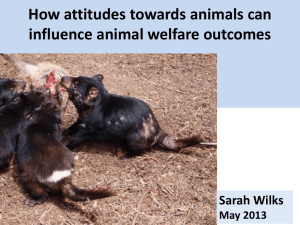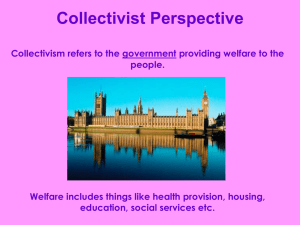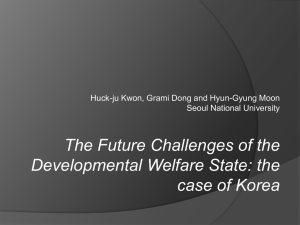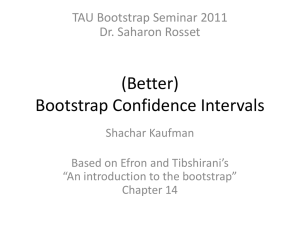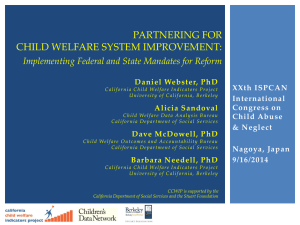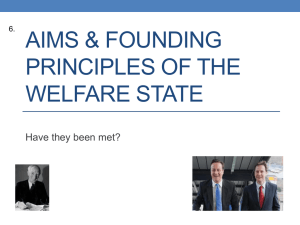u4-bca-slides - Rock Ethics Institute
advertisement
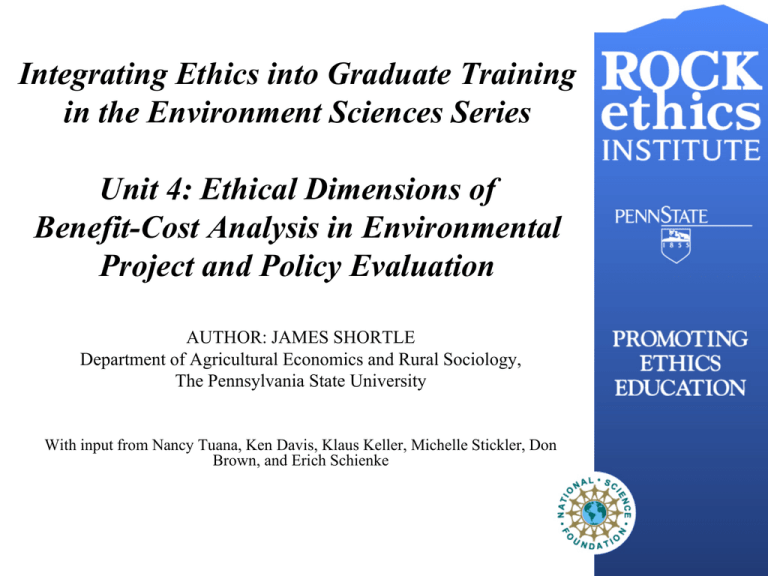
Integrating Ethics into Graduate Training in the Environment Sciences Series Unit 4: Ethical Dimensions of Benefit-Cost Analysis in Environmental Project and Policy Evaluation AUTHOR: JAMES SHORTLE Department of Agricultural Economics and Rural Sociology, The Pennsylvania State University With input from Nancy Tuana, Ken Davis, Klaus Keller, Michelle Stickler, Don Brown, and Erich Schienke Benefit-Cost Analysis (BCA) • An analytical technique for evaluating the economic efficiency of projects or policies based on evaluation of economic benefits and costs • Has become common in the U.S. and other countries • Widely used by EPA and Congress for many statutes in the US. (Hahn 2000 & Adler and Posner 1999) Ethical Issues in BCA • Issues within the welfare economics paradigm – BCA is emerges from an explicit set of value judgments – Ethical issues arise when applications and uses are inconsistent with the underlying norms • Issues about the paradigm – Disagreement with the underlying value judgments • Conduct of BCA Uses of BCA – Ex ante evaluation • • • • Systematic & logically consistent accounting of impacts Tool for ranking competing projects or policies A filter for negative sum rent seeking projects, Inform policy makers about economically efficient outcomes – Ex post evaluation • How well did policies actually work? • Tool for improving future policy based on actual experience Normative Foundations of BCA • BCA emerges from an explicit normative foundation that seeks to answer the fundamental question of applied welfare economics: What is the impact (both sign and magnitude) of a change in resource allocation on social welfare? The Values of Welfare Economics – Social welfare is an aggregation of human welfare • Any consideration for nature in BCA is a derivative of the contribution of the same to human welfare – Individual human welfare is a function of “goods” consumed • The focus is on outcomes, not procedures • Individual’s preferences are the basis for evaluating their welfare outcomes – Individual’s preferences are the basis for evaluating their welfare outcomes • Consumer sovereignty • No moral judgments about individual preferences Evaluation of Social Welfare Change • Simple cases – welfare impacts are beneficial or detrimental for all – If beneficial, such a policy/project would either have all favorable votes or some favorable but no unfavorable votes in a referendum – If detrimental, the reverse would be true • Contentious cases – changes in resource allocation benefit some, harm others – Such a policy or project would have some favorable and some unfavorable votes in a referendum • Question: – How to evaluate these cases? Criteria for evaluating social welfare change • Pareto Criterion • Compensation Criteria • Samuelson-Bergson Social Welfare Functions Pareto Criterion UA Pareto Optimal State B A D C UB Initial Allocation • Given two social states A & B, B is preferred to A if in moving from A to B at least one individual is made better off and no one is made worse off. Limitations of the Pareto Criterion • Incomplete ranking of social states – Alternative optima are non-comparable, for example B, C, and D. • Conservative Re-enforcement – Favors the status quo when trade-offs are involved Compensation Criteria • Test whether changes in resource allocation are potential Pareto Improvements. Based on the concept of potential compensation – Hick’s Criterion- maximum WTP of losers greater than minimum WTA of gainers. Property rights lie with gainers – Kaldor’s Criterion- maximum WTP of gainers greater than minimum WTA of losers. Property rights lie with losers • BCA is the empirical implementation of compensation tests • Compensation criteria are efficiency tests that ignore distributional issues Attributes of Compensation Criteria • Compensation tests are tests of economic efficiency gains – More complete ranking than Pareto Criterion. Allows comparison between • Second best social states • First best and second best states – But still incomplete… – Cannot rank different first-best states – Possibilities of logical inconsistency • Intransitive rankings • Possibility of reversal Social Welfare Functions • It is a real-valued function that maps from the welfare of individuals to the welfare of society W=W(UA, UB.....) • Can provide a complete ranking of social outcomes Challenges in SWF analysis • Choice of the social welfare function – Two approaches • Axiomatic Approach- form of function on the basis of axioms about individual preferences (Arrows Impossibility Theorem) • Moral Justice Approach- functional form arrived at on the basis of moral considerations (Which rule?) – Measurement of Individual Welfare What does this mean? • BCA is only one part of the economic welfare assessment – Welfare assessment entails deliberation on economic efficiency - BCA provides information to the effect – When working within the paradigm, information should be combined with conclusions arrived at on the basis of equity principles using other methods Ethical Issues within the Paradigm • To be developed: Issues will include – Appropriate uses – Issues related to the implementation of the technique Ethical Issues about the Paradigm • Outcomes versus decision making processes – Procedural justice- regarding how a decision is made – Citizen participation- regarding whether there is democracy • Rights and Duties – BCA focuses on anthropocentric welfare only – Importance of nature in BCA contingent on nature’s importance to man – BCA figures do not reflect the impact of the project or policy on nature Discussion Issues • When would we be comfortable using BCA? – How much importance should we place on the absent ethical issues? • When can decision making solely depend on BCA? • How to consider catastrophic effects like hurricanes and other natural disasters in BCA? THANK YOU!

